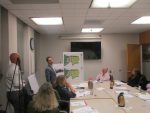New Castle Officials: Rosehill Doesn’t Comply With Comp Plan

New Castle officials told a New Jersey-based developer last week that his revised plans to develop a portion of the former Legionaries property on Route 128 lacked consistency with the town’s draft Comprehensive Plan.
Soder Real Estate Equities’ returned Feb. 28 with updated sketches for its project known as Rosehill, offering two new scenarios, each containing more than 60 units at the site. One proposal calls for a series of 13 structures with between three and six units each and six small single-family homes on Tripp Street.
Another option would see a main building containing 30 condominiums at the same location as the current deteriorating structure with several smaller multiunit structures and single-family houses.
Developer Stephen Oder and his attorney, David Steinmetz, requested a zone called the Previously Developed Estate or Institutional Property Preservation (PDPP) Floating District. The 97-acre parcel land is currently zoned two-acre residential, but with steep slopes, wetlands and other environmental limitations at the site, no more than 12 to 14 single-family homes would likely fit.
Oder had also sought to move forward with a revised Draft Environmental Impact Statement (DEIS).
While the town board complimented Oder for his willingness to work with the town and neighbors on Tripp Street and Rose Hill and for unveiling an impressive plan, the failure to address more points in the new Comprehensive Plan made officials hesitant. The town board is expected to soon set public hearing dates for the draft plan with anticipated adoption within several months.
“We can’t carve this property out of the Comp Plan even though it hasn’t been formally adopted yet. It has to be part of the plan,” said Councilwoman Lisa Katz.
“We have to make this proposed development fit within some of the confines of the plan,” she added.
Councilman Adam Brodsky said he had difficulty reconciling multifamily housing that carries a sharp increase in density in low-density areas of town while the new plan, nearly five years in the making, calls for new development in the hamlet centers.
“What we’re looking at tonight does not comply with the Comprehensive Plan, in my view,” Brodsky said.
Oder said he understood that he couldn’t change the site’s location but his proposal addresses some of the lifestyle options that aren’t currently met in town.
He also said that he wouldn’t build single-family houses on the site because there isn’t a market for that type of development. Oder then revealed that he’s been receiving offers from religious institutions and various organizations interested in buying the land but has so far resisted.
Despite town officials and neighbors deeply concerned over density, developing the site requires a certain number of units.
“You can’t just chop away, chop away,” said Oder, who did not specify a minimum threshold of units. “Then what am I doing this for? I’m not doing this for my health.”
Steinmetz said while the parcel’s location can’t be changed, the housing mix, units ranging from $600,000 to $2.5 million and from about 2,500 square feet to 4,500 square feet, does speak to some of the varied housing needs the town lacks and what the Comprehensive Plan is trying to address.
Furthermore, there isn’t a market to develop much single-family housing in northern Westchester, he said.
“There’s nothing wrong with you guys thinking a little out of the box, and I know there are maybe folks on the planning board and the Comp Plan (Steering Committee) who will disagree with me because the outlying neighborhoods should not be presented with a different type of development,” Steinmetz said. “Well, that’s not what many planners will tell you.”
In addition to the location, Supervisor Robert Greenstein said he was concerned that the proposed sale prices were too expensive. If residents were looking to downsize from a large single-family house, he didn’t see why they would move there.
Greenstein also said that if there are other benefits to the town, such as connecting the neighbors up to town water, which the development would use, the board might look upon a multifamily proposal at the site more favorably.

Martin has more than 30 years experience covering local news in Westchester and Putnam counties, including a frequent focus on zoning and planning issues. He has been editor-in-chief of The Examiner since its inception in 2007. Read more from Martin’s editor-author bio here. Read Martin’s archived work here: https://www.theexaminernews.com/author/martin-wilbur2007/
